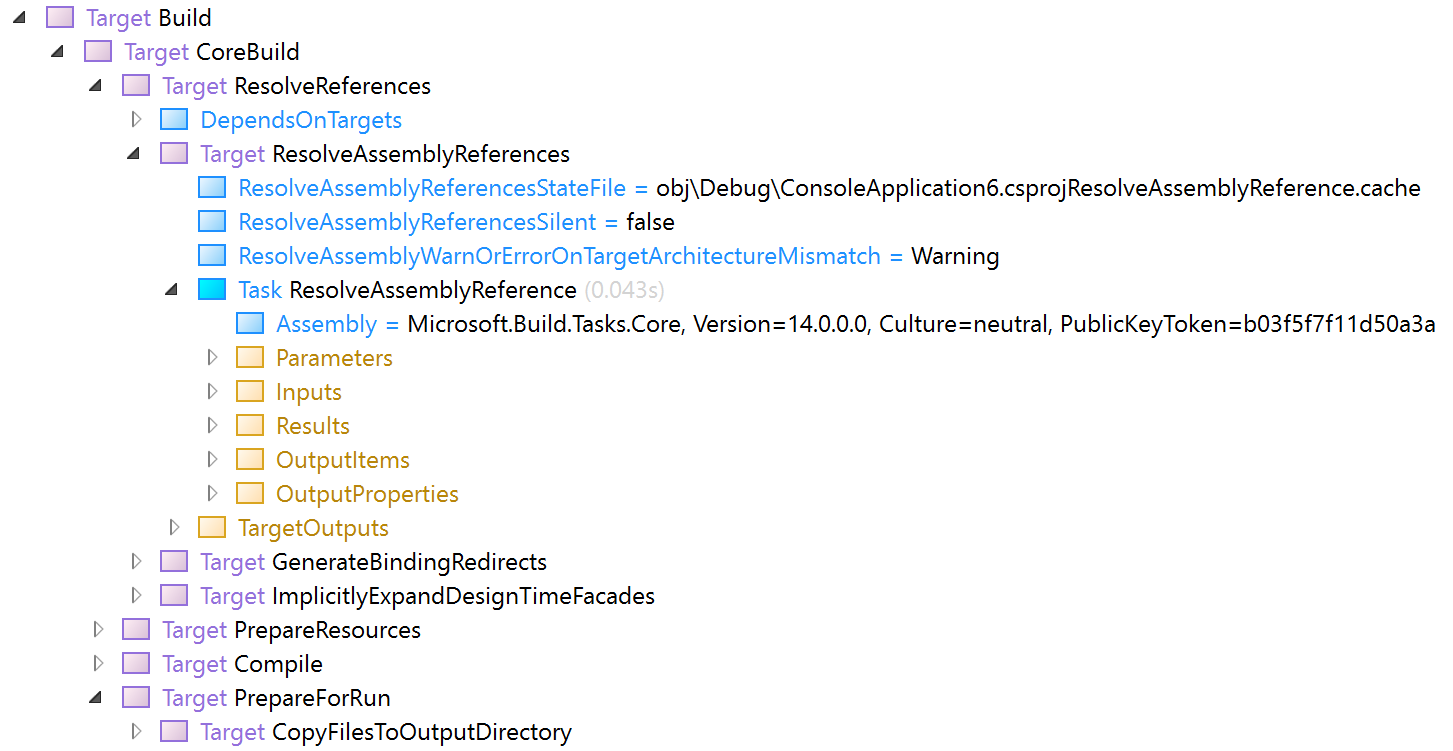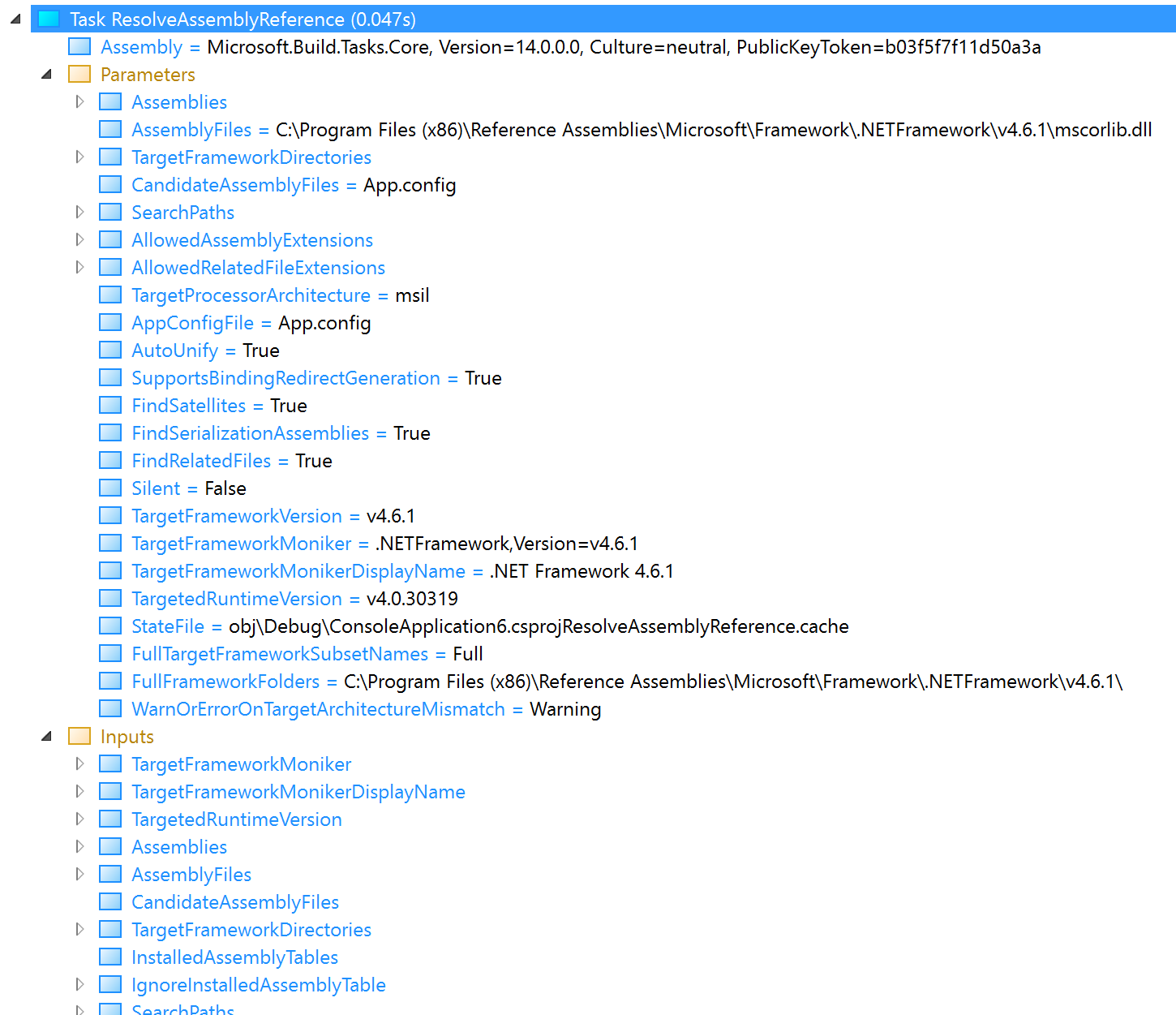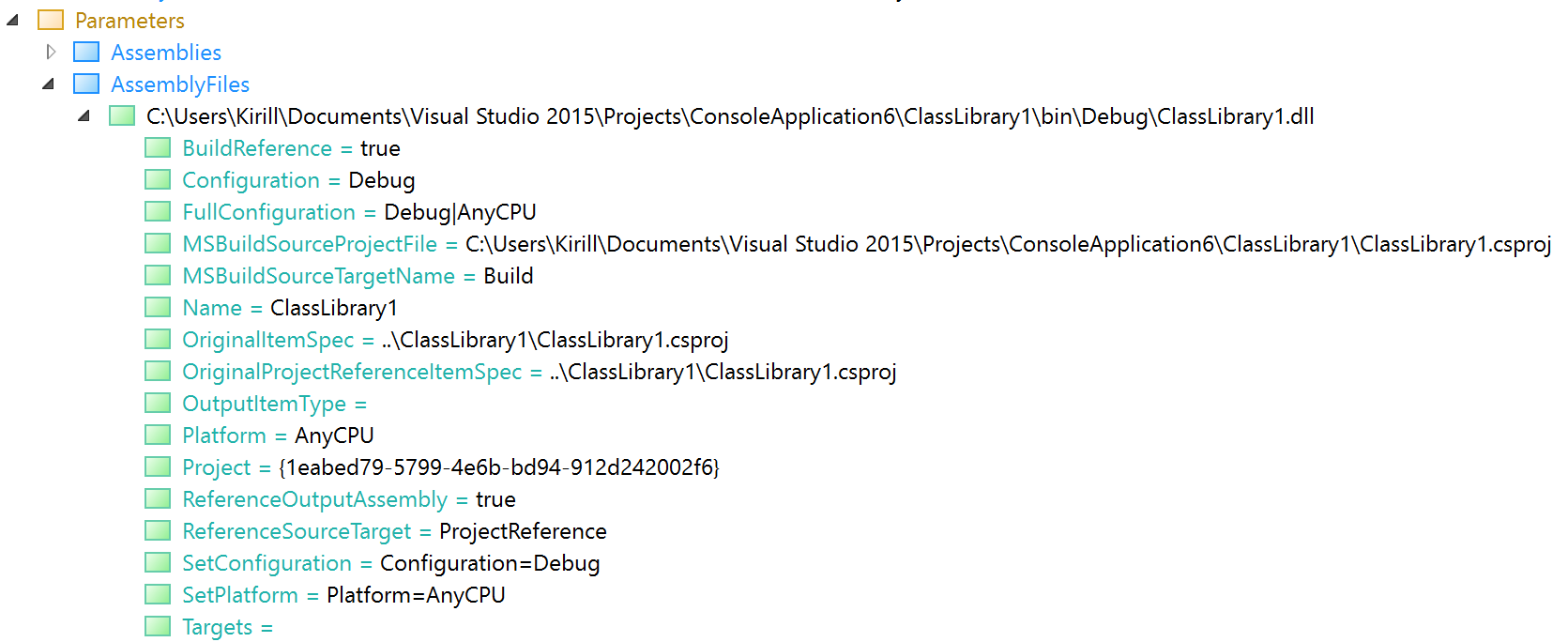Troubleshoot assembly references
One of the most important tasks in MSBuild and the .NET build process is resolving assembly references, which happens in the ResolveAssemblyReference task. This article explains some of the details of how ResolveAssemblyReference works, and how to troubleshoot build failures that can happen when ResolveAssemblyReference is unable to resolve a reference. To investigate assembly reference failures, you might want to install the Structured Log Viewer to view MSBuild logs. The screenshots in this article are taken from the Structured Log Viewer.
The purpose of ResolveAssemblyReference is to take all the references specified in .csproj files (or elsewhere) via the <Reference> item and map them to paths to assembly files in the filesystem.
The compilers only can accept a .dll path on the filesystem as a reference, so ResolveAssemblyReference converts strings like mscorlib, Version=4.0.0.0, Culture=neutral, PublicKeyToken=b77a5c561934e089 that appear in project files to paths like C:\Program Files (x86)\Reference Assemblies\Microsoft\Framework\.NETFramework\v4.6.1\mscorlib.dll, which are then passed to the compiler via the /r switch.
Additionally ResolveAssemblyReference determines the complete set (actually the transitive closure in graph theory terms) of all .dll and .exe references recursively, and for each of them determines whether it should be copied to the build output directory or not. It doesn't do the actual copying (that is handled later, after the actual compile step), but it prepares an item list of files to copy.
ResolveAssemblyReference is invoked from the ResolveAssemblyReferences target:

If you notice the ordering, ResolveAssemblyReferences is happening before Compile, and of course, CopyFilesToOutputDirectory happens after Compile.
Note
ResolveAssemblyReference task is invoked in the standard .targets file Microsoft.Common.CurrentVersion.targets in the MSBuild installation folders. You can also browse the .NET SDK MSBuild targets online at https://github.com/dotnet/msbuild/blob/a936b97e30679dcea4d99c362efa6f732c9d3587/src/Tasks/Microsoft.Common.CurrentVersion.targets#L1991-L2140. This link shows exactly where the ResolveAssemblyReference task is invoked in the .targets file.
ResolveAssemblyReference inputs
ResolveAssemblyReference is comprehensive about logging its inputs:

The Parameters node is standard for all tasks, but additionally ResolveAssemblyReference logs its own set of information under Inputs (which is basically the same as under Parameters, but structured differently).
The most important inputs are Assemblies and AssemblyFiles:
<ResolveAssemblyReference
Assemblies="@(Reference)"
AssemblyFiles="@(_ResolvedProjectReferencePaths);@(_ExplicitReference)"
Assemblies uses the contents of the Reference MSBuild item at the moment when ResolveAssemblyReference is invoked for the project. All the metadata and assembly references, including your NuGet references, should be contained in this item. Each reference has a rich set of metadata attached to it:

AssemblyFiles comes from ResolveProjectReference target's output item called _ResolvedProjectReferencePaths. ResolveProjectReference runs before ResolveAssemblyReference and it converts <ProjectReference> items to paths of built assemblies on disk. So the AssemblyFiles will contain the assemblies built by all referenced projects of the current project:

Another useful input is the boolean FindDependencies parameter, which takes its value from the _FindDependencies property:
FindDependencies="$(_FindDependencies)"
You can set this property to false in your build to turn off analyzing transitive dependency assemblies.
ResolveAssemblyReference algorithm
The simplified algorithm for the ResolveAssemblyReference task is as follows:
- Log inputs.
- Check the
MSBUILDLOGVERBOSERARSEARCHRESULTSenvironment variable. Set this variable to any value to get more detailed logs. - Initialize the table of references object.
- Read the cache file from the
objdirectory (if present). - Compute the closure of dependencies.
- Build the output tables.
- Write the cache file to the
objdirectory. - Log the results.
The algorithm takes the input list of assemblies (both from metadata and project references), retrieves the list of references for each assembly it processes (by reading metadata) and builds a complete set (transitive closure) of all referenced assemblies, and resolves them from various locations (including the GAC, AssemblyFoldersEx, and so on).
Referenced assemblies are added to the list iteratively until no more new references are added. Then the algorithm stops.
Direct references that you provided to the task are called Primary references. Indirect assemblies that were added to the set because of a transitive reference are called Dependency. The record for each indirect assembly keeps track of all the primary ("root") items that led to its inclusion and their corresponding metadata.
Results of the ResolveAssemblyReference task
ResolveAssemblyReference provides detailed logging of the results:

Resolved assemblies are divided into two categories: Primary references and Dependencies. Primary references were specified explicitly as references of the project being built. Dependencies were inferred from references of references transitively.
Important
ResolveAssemblyReference reads assembly metadata to determine the references of a given assembly. When the C# compiler emits an assembly, it only adds references to assemblies that are actually needed. So, it might happen that when you compile a certain project, the project may specify an unneeded reference that won't be baked into the assembly. It's OK to add references to project that are not needed; they are ignored.
CopyLocal item metadata
References can also have the CopyLocal metadata or not. If the reference has CopyLocal = true, it will later be copied to the output directory by the CopyFilesToOutputDirectory target. In this example, DataFlow has CopyLocal set to true, while Immutable does not:

If the CopyLocal metadata is missing entirely, it's assumed to be true by default. So ResolveAssemblyReference by default tries to copy dependencies to output unless it finds a reason not to. ResolveAssemblyReference records the reasons why it chose a particular reference to be CopyLocal or not.
All possible reasons for CopyLocal decision are enumerated in the following table. It's useful to know these strings to be able to search for them in build logs.
| CopyLocal state | Description |
|---|---|
Undecided |
The copy local state is undecided right now. |
YesBecauseOfHeuristic |
The reference should have CopyLocal='true' because it wasn't 'no' for any reason. |
YesBecauseReferenceItemHadMetadata |
The Reference should have CopyLocal='true' because its source item has Private='true' |
NoBecauseFrameworkFile |
The reference should have CopyLocal='false' because it is a framework file. |
NoBecausePrerequisite |
The reference should have CopyLocal='false' because it is a prerequisite file. |
NoBecauseReferenceItemHadMetadata |
The reference should have CopyLocal='false' because the Private attribute is set to 'false' in the project. |
NoBecauseReferenceResolvedFromGAC |
The reference should have CopyLocal='false' because it was resolved from the GAC. |
NoBecauseReferenceFoundInGAC |
Legacy behavior, CopyLocal='false' when the assembly is found in the GAC (even when it was resolved elsewhere). |
NoBecauseConflictVictim |
The reference should have CopyLocal='false' because it lost a conflict between a same-named assembly file. |
NoBecauseUnresolved |
The reference was unresolved. It can't be copied to the bin directory because it wasn't found. |
NoBecauseEmbedded |
The reference was embedded. It shouldn't be copied to the bin directory because it won't be loaded at runtime. |
NoBecauseParentReferencesFoundInGAC |
The property copyLocalDependenciesWhenParentReferenceInGac is set to false and all the parent source items were found in the GAC. |
NoBecauseBadImage |
The assembly file provided should not be copied because it is a bad image, possibly not managed, possibly not an assembly at all. |
Private item metadata
An important part of determining CopyLocal is the Private metadata on all primary references. Each reference (primary or dependency) has a list of all primary references (source items) that have contributed to that reference being added to the closure.
- If none of the source items specify
Privatemetadata,CopyLocalis set toTrue(or not set, which defaults toTrue) - If any of the source items specify
Private=true,CopyLocalis set toTrue - If none of the source assemblies specify
Private=trueand at least one specifiesPrivate=false,CopyLocalis set toFalse
Which reference set Private to false?
The last point is an often used reason for CopyLocal being set to false:
This reference is not "CopyLocal" because at least one source item had "Private" set to "false" and no source items had "Private" set to "true".
MSBuild doesn't tell us which reference has set Private to false, but the structured log viewer adds Private metadata to the items that had it specified above:

This simplifies investigations and tells you exactly which reference caused the dependency in question to be set with CopyLocal=false.
Global Assembly Cache
The Global Assembly Cache (GAC) plays an important role in determining whether to copy references to output. This is unfortunate because the contents of the GAC is machine-specific and this results in problems for reproducible builds (where the behavior differs on different machine dependent on machine state, such as the GAC).
There were recent fixes made to ResolveAssemblyReference to alleviate the situation. You can control the behavior by these two new inputs to ResolveAssemblyReference:
CopyLocalDependenciesWhenParentReferenceInGac="$(CopyLocalDependenciesWhenParentReferenceInGac)"
DoNotCopyLocalIfInGac="$(DoNotCopyLocalIfInGac)"
AssemblySearchPaths
There are two ways to customize the list of paths ResolveAssemblyReference searches in attempting to locate an assembly. To fully customize the list, the property AssemblySearchPaths can be set ahead of time. The order matters; if an assembly is in two locations, ResolveAssemblyReference stops after it finds it at the first location.
By default, there are ten locations ResolveAssemblyReference searches (four if you use the .NET SDK), and each can be disabled by setting the relevant flag to false:
- Searching files from the current project is disabled by setting the
AssemblySearchPath_UseCandidateAssemblyFilesproperty to false. - Searching the reference path property (from a
.userfile) is disabled by setting theAssemblySearchPath_UseReferencePathproperty to false. - Using the hint path from the item is disabled by setting the
AssemblySearchPath_UseHintPathFromItemproperty to false. - Using the directory with MSBuild's target runtime is disabled by setting the
AssemblySearchPath_UseTargetFrameworkDirectoryproperty to false. - Searching assembly folders from AssemblyFolders.config is disabled by setting the
AssemblySearchPath_UseAssemblyFoldersConfigFileSearchPathproperty to false. - Searching the registry is disabled by setting the
AssemblySearchPath_UseRegistryproperty to false. - Searching legacy registered assembly folders is disabled by setting the
AssemblySearchPath_UseAssemblyFoldersproperty to false. - Looking in the GAC is disabled by setting the
AssemblySearchPath_UseGACproperty to false. - Treating the reference's Include as a real file name is disabled by setting the
AssemblySearchPath_UseRawFileNameproperty to false. - Checking the application's output folder is disabled by setting the
AssemblySearchPath_UseOutDirproperty to false.
There was a conflict
A common situation is MSBuild gives a warning about different versions of the same assembly being used by different references. The solution often involves adding a binding redirect to the app.config file.
A useful way to investigate these conflicts is to search in MSBuild Structured Log Viewer for "There was a conflict". It shows you detailed information about which references needed which versions of the assembly in question.